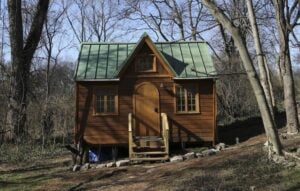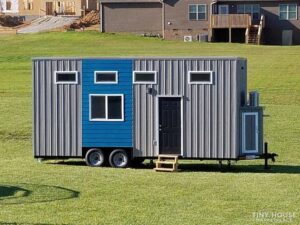Blog

A Guide To Tiny House Insurance
A Guide To Tiny House Insurance
Tiny houses are becoming more popular alternative housing options in the United States for many good reasons. These miniature homes are easy to maintain, energy-efficient, cost-effective, and allow you to live a simpler life. Plus, there’s no room for things you don’t need or clutter.
Just like regular or traditional homes, tiny houses aren’t impenetrable. Natural disasters such as floods or storms can cause damage to your home and property. Or your tiny home could suffer damage from a fire.
Thankfully, there’s tiny house insurance that can cover your property and belongings. Got a tiny house? If yes, check out our guide on tiny house insurance.
Note: Check out our article on 10 things no one tells you about Tiny homes.
What Is A Tiny House?
A tiny, miniature house is indeed what it sounds like—it’s a small home. Although there are no official size limits, they are usually sized not more than 600 square feet. Tiny houses can be built or constructed on trailers or permanent foundations.
Those who’d love to move and get around may want a tiny house on wheels. It allows you to live in your home and go anywhere you like, provided there’s an electrical hookup nearby. However, if your dream is to live off-grid in nature, then building a permanent foundation for your tiny house is advisable.
Regardless, tiny houses are perfect for those who want to transition to a simpler life and want to save money on utilities.
Can You Get Tiny Home Insurance?
Tiny homes may be small and cute, but the responsibilities of owning one can be pretty significant. That’s why insurance is essential for anyone who owns a tiny home or is considering buying one. Also, depending on the type of home (on wheels or stationary), you’ll need a mobile home policy or an RV policy to protect your investment.
Mobile home insurance generally covers a tiny house built on a permanent foundation and stationary, where you live full-time. On the other hand, RV insurance covers a tiny house built on wheels or a trailer.
Both tiny house insurance policies will safeguard and protect your tiny home and the things inside from perils like theft, fire, windstorms, and more. They also include liability insurance if someone sues you for injuries or property damage caused by your home.
Cost of Tiny House Insurance

The cost of tiny house insurance typically depends on various factors such as your location, type of tiny house, whether it’s certified, and how you use it. Generally, you can expect to pay around $400 to $1,500 per year for coverage.
Mobile home insurance policies are more affordable than RV policies because the latter protects the house while in transit. And it puts the house at a much higher risk of theft and damage, which means higher premiums.
Other than that, tiny house insurance costs also depend on the deductible and coverage limits you choose. Be sure to compare home insurance quotes and speak with a professional insurance agent to determine the cost.
How to Insure Your Tiny Home

Before taking off on your tiny-home adventure, you should know a few things about getting insured for your new tiny house. Many insurance companies offer coverage for tiny homes (accessory dwelling units, custom RVs, park models, storage container homes, micro homes, off-the-grid cabins, DIY homes, and more).
You need to find the right insurer first. From there, you’ll be able to compare free quotes and select a tiny homeowners policy and insurance coverage that covers your needs and fits within your budget.
If your house is on wheels, an RV policy is the best option. It’s designed for travelers and includes provisions like collision coverage. For you to qualify for an RV policy, your tiny home must meet the requirements created by the Recreational Vehicle Industry Association (RVIA).
Check RVIA’s official site to see if your tiny home qualifies. Moreover, the basic RV policy usually includes the following coverage:
- medical payment
- replacement cost
- personal property coverage
- towing
- uninsured/underinsured motorist
- personal liability
On the other hand, if NOAH-certified home builders construct your tiny house in a permanent location, then a mobile home policy is for you. Like a standard homeowners insurance, a comprehensive mobile manufactured home insurance policy covers the liability coverage claims, your personal property, and the home.
But, unlike RV policies, this tiny home insurance doesn’t cover your personal belongings. So, you’ll need to buy a separate policy for that from the same insurance agency or another insurance provider.
Other Things To Know About Tiny House Insurance
Here are a few other things to know about tiny house insurance:
Who needs tiny home insurance?
People who want to protect their investment. Most homeowners have a homeowners or renters insurance policy, but you might not get covered for certain things if you live in a tiny house. So, it’s important to do your research for tiny house insurance options and make sure that your tiny house is properly insured.
Who qualifies for tiny home insurance?
In order to qualify for tiny house property insurance, your house must fit in a particular size range. Most companies require that your house be between 100 and 400 square feet with 10 square feet per person of living space.
What type of coverage options do you need?
The type of insurance products you’ll need for your tiny house will depend on many factors, including where you live and how much money you have invested in your home. Consider all these things before making any decisions about your policy.
Is tiny house insurance required?
If you finance your tiny house yourself and it’s stationary, you’re not legally bound to insure it. But once it hits the road, it’s required by law to be insured as RVs or get car insurance.
Takeaway
Tiny house living or tiny house movement is a growing trend in the United States (but it isn’t for everyone). Many people are choosing to downsize and live in smaller spaces, reducing their overall cost of living expenses and making them happier with what they have.
Just keep in mind to research tiny house insurance companies and buy a good insurance policy for your tiny home to protect it from damage or theft. This way, you can be sure that you won’t be left out in the cold if something happens to your home and get peace of mind knowing that you and your house are protected.